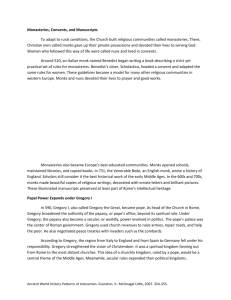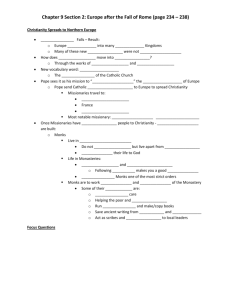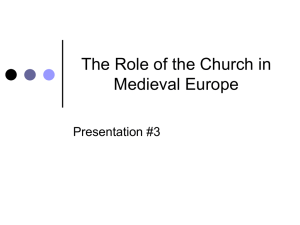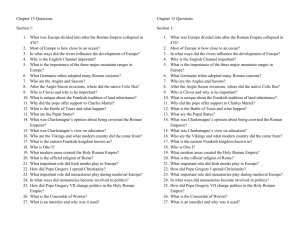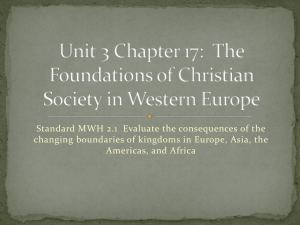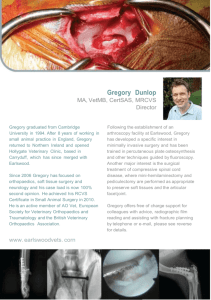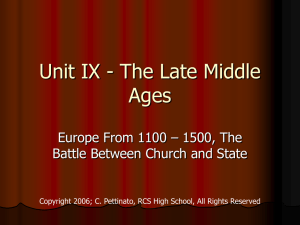Chapter 10 - 600 Years in the East (451-1054)
advertisement
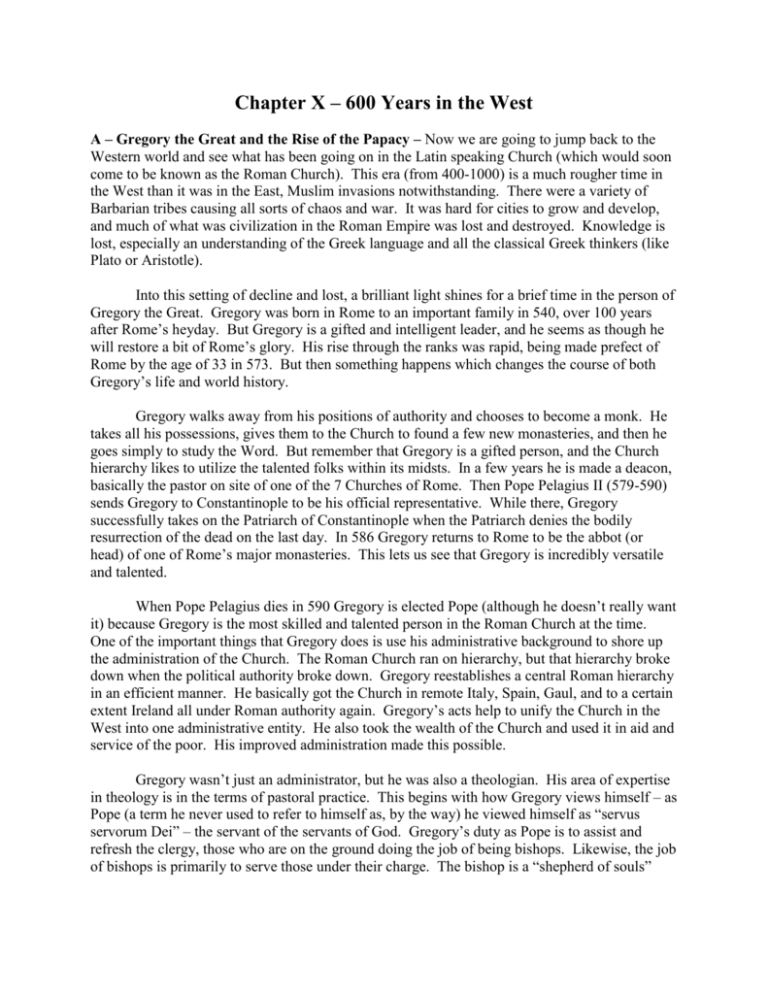
Chapter X – 600 Years in the West A – Gregory the Great and the Rise of the Papacy – Now we are going to jump back to the Western world and see what has been going on in the Latin speaking Church (which would soon come to be known as the Roman Church). This era (from 400-1000) is a much rougher time in the West than it was in the East, Muslim invasions notwithstanding. There were a variety of Barbarian tribes causing all sorts of chaos and war. It was hard for cities to grow and develop, and much of what was civilization in the Roman Empire was lost and destroyed. Knowledge is lost, especially an understanding of the Greek language and all the classical Greek thinkers (like Plato or Aristotle). Into this setting of decline and lost, a brilliant light shines for a brief time in the person of Gregory the Great. Gregory was born in Rome to an important family in 540, over 100 years after Rome’s heyday. But Gregory is a gifted and intelligent leader, and he seems as though he will restore a bit of Rome’s glory. His rise through the ranks was rapid, being made prefect of Rome by the age of 33 in 573. But then something happens which changes the course of both Gregory’s life and world history. Gregory walks away from his positions of authority and chooses to become a monk. He takes all his possessions, gives them to the Church to found a few new monasteries, and then he goes simply to study the Word. But remember that Gregory is a gifted person, and the Church hierarchy likes to utilize the talented folks within its midsts. In a few years he is made a deacon, basically the pastor on site of one of the 7 Churches of Rome. Then Pope Pelagius II (579-590) sends Gregory to Constantinople to be his official representative. While there, Gregory successfully takes on the Patriarch of Constantinople when the Patriarch denies the bodily resurrection of the dead on the last day. In 586 Gregory returns to Rome to be the abbot (or head) of one of Rome’s major monasteries. This lets us see that Gregory is incredibly versatile and talented. When Pope Pelagius dies in 590 Gregory is elected Pope (although he doesn’t really want it) because Gregory is the most skilled and talented person in the Roman Church at the time. One of the important things that Gregory does is use his administrative background to shore up the administration of the Church. The Roman Church ran on hierarchy, but that hierarchy broke down when the political authority broke down. Gregory reestablishes a central Roman hierarchy in an efficient manner. He basically got the Church in remote Italy, Spain, Gaul, and to a certain extent Ireland all under Roman authority again. Gregory’s acts help to unify the Church in the West into one administrative entity. He also took the wealth of the Church and used it in aid and service of the poor. His improved administration made this possible. Gregory wasn’t just an administrator, but he was also a theologian. His area of expertise in theology is in the terms of pastoral practice. This begins with how Gregory views himself – as Pope (a term he never used to refer to himself as, by the way) he viewed himself as “servus servorum Dei” – the servant of the servants of God. Gregory’s duty as Pope is to assist and refresh the clergy, those who are on the ground doing the job of being bishops. Likewise, the job of bishops is primarily to serve those under their charge. The bishop is a “shepherd of souls” who is to lead and teach the people in the Church. His book “Pastoral Rule” is a classic dealing with the how of pastoral care. However, Gregory couldn’t quite escape his past as a civil administrator. Remember that for 200 years now the people of Rome have turned to the Pope when the civil government began to falter. When they appealed to Gregory to intercede for Rome with invading tribes – Gregory did, and did so incredibly well. And Gregory felt he needed to – in serving the souls under his spiritual care. Because he wanted to be a good Pastor, Gregory takes over in Rome. Gregory ends up establishing treaties between the various powerful kings of Western Europe and the Emperor, but in so doing firmly establishes the Papacy as the temporal authority of Rome itself. Popes that would come after Gregory would further expand the political authority which Gregory took on. There are some aspects of Gregory’s Papacy that are very overtly negative. While in many ways he is a great theologian, he does drop the ball in two dramatic ways that have a profound negative impact upon the Western Church. Gregory is the first Pope who was a monk prior to being Pope. He is the first Pope to really come from that background, and one of the things that was very prevalent in the monastic life was the idea of Satisfaction. Gregory said that while Jesus indeed that man, fallen and sinful, is rescued from sin in Baptism on account of the life and death and resurrection of Christ. However, Gregory also was firm in stating that for sins which occurred after Baptism, satisfaction must be made. Christians, using God’s Grace, make confession and then do good works which make up for our sins after Baptism. Gregory says that God gives us strength to do this through the Lord’s Supper and because of the prayers of the saints and martyrs. But what happens to the Baptized Christian who hasn’t made satisfaction for all of his post-baptismal sins? Gregory really pushed the idea of Purgatory – a place of purgation, or cleansing between this world and heaven. Gregory didn’t create the idea – it had been a rough theory or possibility that was considered in the West for hundreds of years – but Gregory is the one who basically gets the Church to say that Purgatory is an article of faith – Purgatory became no longer just a theory but the official teaching of the Church under Gregory’s lead. A lot of this focus stems from Gregory’s experience in the monastic life. As a monk, Gregory had stepped out of the world and focused on living a life of good works – a life where his continual focus had become on making satisfaction for his sins. That was one of the common foci of a monk – right and holy living. And indeed, if we wrong someone we should make up for it – but that’s a matter of life here on the earth and not our eternal salvation. But Gregory kept this monastic attitude and helped to incorporate it into the Church at large. Over the next 400 years tension will develop between the Regular clergy (those who were monks, from a “rule”) and the Secular clergy (those who were just normal clergy) as the clergy who come from the monastic background have a stricter, more legalistic sense of what Christianity is. Gregory’s papacy helps give the ideals of monasticism a stronger foothold in the Western Church’s overall power structure and helps to spread the ideals of monasticism. He was a good pope, and he came from the monasteries – so a lot more people begin to think that maybe the monasteries are the way to go. Nevertheless, even with these problems, Gregory is a fine pope. In fact, in many ways Gregory is the last “good” pope. Even though he had some bad theology, he still focused on theology. The popes after him soon abandon the theological function and focus more and more on politics. Local Roman families fight to have sons become pope simply to exercise the Papacy’s expanding political power. The decay is so fierce that by the 900s the Papacy is completely corrupt. This era is referred to as the “pornocracy” or the “rule of harlots” – where basically the popes were hard living party people – with prostitutes having the run of the Churches. Gregory unfortunately touches this off by expanding the political power of the Pope – but he still was a decent, sincere man. He also did many other things – including working on the Church’s hymns – we still sing Gregorian Chants to this day. But Gregory marks a turning point for the Roman Catholic Church. The aftermath of many of his decisions turn the papacy towards the worse. B – The Rise of Monasticism – Monasticism, or the practice of people becoming monks and nuns, is one of those trends that becomes so important in the history of the Church that it almost overwhelms it. For over 1000 years the typical image of a good, pious Christian is a humble monk – whether it be real figures like St. Francis, or legendary, like Friar Tuck. It is in this time period that the Monastic ideal begins to spread across Western Christianity. You may remember that Monasticism began in the deserts of Egypt in the late 3rd Century. There in Egypt men would forsake the world and go and live in isolation in the desert pondering the mysteries of God. Eventually groups of these men would band together, pondering the mysteries of God in a communal setting. One of the biggest proponents of Monasticism was St. Athanasius – and when he was exiled to Europe he brought the idea of Monasticism with him and helped popularize it. Monasticism began to spread slowly across the lands of the Roman Empire. As a good example of this, we will take a good look at St. Patrick (c.490-461). Patrick was born in western England towards the end of the 4th Century, the son of a local deacon. However, the Romans abandoned England when he was in his late teens, and various barbarians ravaged the country. Patrick was captured when he was 16 by Irish raiders and sold into slavery. He escapes after a few years and flees back to England, where he enters a monastery for 12 years. However, he has a dream or vision where voices beg him to return to Ireland, so he does, this time as a missionary. Patrick is tireless in converting the Irish (which he records in his autobiography entitled Confessio) and establishes many Churches there. He also establishes many monasteries and encourages people to escape the troubles of the world and its temptations in solitary contemplation. Patrick’s monasteries also served as hospitals, libraries (the monks would copy and preserve texts), and fortresses in case of barbarian raiders. The monasteries became a place of safety as the world became more dangerous and less civilized, so their popularity spread throughout Ireland. This will be vitally important for Church, and world History, as we will see in a later section. Monasticism also begins to spread in southern Europe. The man most famous in this regards is St. Benedict (c. 480-561). Benedict was born into a wealthy family is the town of Nursia in Italy. While he is engaged in his literary studies in Rome as 20 year old, he ends up running off to become a monk in order to avoid sexual temptation. He heads of into the Italian mountains to have seclusion and peace for his studies on the Gospels and Christ. He meets a wandering monk named Romanus who convinces him to study in a cave for three years. At the end of these three years, the monks of a nearby monastery beg Benedict to become their abbot (the former had just died). Benedict agrees. However, Benedict sets down some strict rules, which the monks don’t like, and they try to kill him. Benedict survives and flees back to his cave, having decided on abandoning the undisciplined life of the monks and returning to just being a hermit. However, many people hear about Benedict and what he has done, and they start to flock to him. Benedict doesn’t want them around, but he finally gives in and begins to establish monasteries for those who would follow his rules. In fact, he writes what comes to be known as “The Rule of St. Benedict” which becomes the standard set of rules for living in a monastery. Eventually, it becomes what folks living in a monastery in southern Europe have to abide by in order to be recognized by the Church. This is because one of Benedict’s greatest admirers is Gregory the Great, and the monasteries he establishes all follow Benedict’s rules. Benedict’s rule basically sets up monasteries as brotherhoods where all are under the leadership of one, the abbot. The abbot oversees the spiritual life of the monks, seeing that certain daily prayers services are held (such as Matins and Vespers). The monks, in addition to their prayers, were to live lives of service and give aid to those around them such as they could. Benedict spells out simple, practical guidelines for how this is to occur. Monasteries continue to pop up all over Europe in the Centuries come, especially when there is trouble of any sort. The monasteries become places of stability and safety. They end up becoming places where one could quite literally (in the words of the hymn) “flee the world which would deceive us.” As the monasteries grow, some of them become quite wealthy. Some have towns rise up around them. These monasteries end up becoming centers of power in their own right, and some more aggressive abbots will try to exercise their power and influence over others. This trend continues throughout the rest of the millennium and beyond. C – The Great Sacramental Debate – During the Dark Ages the thought and debate in the Church doesn’t happen at the same pace as it does in the Early Church. There are fewer and fewer people who are educated. Even in the Rome Era, people who couldn’t read were familiar with the works of Plato and Aristotle – all they had to do was go out in public and listen to the people reading. The Dark Ages are different – education and knowledge is kept to a smaller and smaller group of people. Travel difficulties slowed communication, so there wasn’t as much interaction. The intellectual back-and-forth that spurred thought slowed. However, it did still happen, and often it was centered in the Monasteries. While many monks were simply folk who lived lives of isolation, those who were attracted to learning, and in particular learning about God were drawn to the monastic system. As such, much of the doctrinal “development” of the dark ages occurs in and around the monasteries rather than around the bishops and pastors of the Church. Many of the ideas that are “Roman Catholic” begin to develop in this setting – the monks help to develop the idea of the Perpetual Virginity of Mary, and the requirement of celibacy for the clergy. The monks are the ones spearheading the popularization of these ideas. However, the monks also end up defending proper doctrine on occasion – their work is sort of a mixed theological bag. What I’d like to do here is look at one of the debates that arose in the middle of the 9th Century as it is informative and a more positive one. This debate was over what the Lord’s Supper is. It was understood that the Lord’s Supper was the center of the Christian’s life – it was the heart of our worship. But two Benedictine monks open up the debate over what the Supper actually is. A monk by the name of Ratramnus raised the question as to if we actually received Christ’s actual Body and Blood in the Supper. Ratramnus claimed that when we commune, we aren’t receiving the Body of Christ that was born of Mary. Rationally, the claim that we receive Christ’s True Body doesn’t make sense. In the first place, we are separated by time and space from Jesus’ life, and thus we are separated from Jesus’ Body. Second, Ratramnus claimed that if the Supper were Christ’s Real and Actual Body, the Supper would cease to be a mystery that we receive by faith. If something is “real” it’s not a mystery – it’s simply what it is. The Supper has to be something beyond Christ’s Body and Blood for it to be something that we receive by faith, otherwise we’d just be using simple observation. The way Ratramnus finally explained the Lord’s Supper is that it isn’t Christ’s real flesh but rather “a sacrament of that flesh.” He claimed that we received basically a symbol of Christ that by faith connects us to Him. Ratramnus was opposed by another Benedictine monk by the name of Radbertus Paschasius. Radbertus was firm in his defense of the Real Presence – he stated that what we received in the Lord’s Supper was “obviously none other than the One that was born of Mary, suffered on the cross, and rose from the grave.” Radbertus said that we must believe that the Supper is the true Body of Christ and not just a symbol or a figure because Christ says “This is my Body,” not “this is the figure of my body.” To understand what the Supper is, we are to go to the Words of Christ, not our reason. The mystery of the Supper is that while we see and taste bread and wine we in fact receive Christ’s True Body and Blood. Even unbelievers and hypocrites receive Christ, but they sin against Him. By faith we believe Christ and receive the benefits of His Supper. Radbertus says, “when truth itself says, ‘This is My Body,’” we believe this because “the words of Christ are as efficacious as they are divine, so that nothing else comes forth other than what they command.” These arguments here presented are almost virtually the same as what will come up in the Reformation between the Reformed (like Zwingli) and Luther. One of Luther’s most famous works is entitled “That the Words of our Lord ‘This is My Body’ Still Stand Against the Fanatics” – which is the same point Radbertus makes. This reminds us of something simple. Satan uses the same tactic over and over again – he tries to have us follow reason and what we think rather than having us cling to the Word. However, in the 9th Century the Church stood firm on Christ’s Real Presence in the Supper. Radbertus is supported and Ratramnus is declared to be wrong. However, this is the Dark Ages, and things keep sliding a bit worse and worse. One of the things that also comes out in this Sacramental debate is the development of the idea of the “Sacrifice of the Mass.” Luther’s biggest qualm with the Roman Catholic Doctrine of his day was the idea that the Lord’s Supper was a re-sacrifice of Jesus – that the priest sacrificed Jesus again for the sake of the people. This flies in the face of Scripture – Hebrews claims that Christ is the ultimate sacrifice, the final one, sacrificed once for all. Over the course of the Dark and Middle Ages, the Roman Catholic Church abandons this truth for doctrines of their own devising. Radbertus is one of the people who helps this development (or error) along. He claims “although Christ, having suffered once for all in the flesh, saved the world once for all through one and the same suffering unto death, this offering is nevertheless repeated daily.” And you can see what happens – he references scripture, but then goes off in completely the opposite direction. You can see how the decline happens. Even Radbertus, who is so strong on paying attention to what Christ says – in this one area ignores the Word in another – and he falls off into error. Over the course of the Dark and Middle Ages less and less attention is paid to the Word. In Radbertus’ time it is occasionally ignored – by Luther’s day it isn’t really even consulted. There is another interesting aspect of this discussion. Both sides quote Augustine and claim that St. Augustine would have agreed with them. One of the elements that begins to arise through the Dark and Middle Ages is that the focus of what theology is done turns more and more to “what does Augustine say?” Everything is viewed through his teachings – which were wide and varied. Often the debate becomes of what Augustine taught. This move paves the way for a change that takes place in the Roman Catholic Church. By Luther’s time, theology is done by the declaration of the Church. What the Pope says, what councils say are right, no questions asked, because that’s what the Church says. During the Dark Ages the moves are done which pull the Church away from Scripture. This is a slow and gradual change. Radbertus relies on Scripture in one aspect, and then ignores it in another. It wasn’t as though one day a bunch of people stood up and said, “now we will ignore the bible.” It was a gradual slip – and some bright lights speak out for the Gospel – but up until the Reformation there is a steady decline. This should be a warning to us today. Error doesn’t just suddenly appear – it can take decades and centuries – so we must always remain on guard and pray that God keeps us steadfast in His Word. There are several other debates and other figures that we could have looked at. The story of theology from 600-1000 is basically a repeat of this story. There are some truths that are defended, and others that fall away as the Church moves slowly away from Scripture. It’s a slow, sad decline. But even in the midst of this decline, the Gospel is present, even if occasionally clouded. And the Gospel spreads. D – The Conquest of Europe – In spite of the problems in doctrine and theology that start to arise in Western Christendom, God still did continue to spread His Gospel through many faithful people in His Church. The time period from 400-1000 is one of incredibly growth and expansion. This is the time period where Europe is by in large converted to Christianity. The Roman Empire was predominately Christian before it’s fall – and as such there had been a strong Christian presence in Spain, Italy, Central France, and Britian. However, there is a lot of Europe besides these areas. Plus, after the fall of the Roman Empire, many of these areas are conquered by pagan or Arian Germanic tribes. Slowly, over the course of the Centuries, the Church makes inroads into these tribes, bringing the Gospel to them. God raised up several men who did fantastic work as missionaries. We will take a look at a few of these now. The first one we will look at is St. Columba (527-597). As you will recall, St. Patrick helped bring Christianity to Ireland and helped to found many monasteries there. Patrick does this just before the Roman Empire collapses. When Rome collapses, Christianity in Britain is virtually wiped out. However, Christianity survives in Ireland – the roaming tribes of England didn’t cross over successfully to Ireland. So Ireland, and in particular the monasteries, become the last bastion of Christian thought and learning in the wild north of Europe. Eventually, the Irish move out from Ireland and bring the Gospel to England. St. Columba ends up spearheading this – although not simply out of the goodness of his heart. In 560, Columba makes a copy of the Psalms. Remember, this is a lot of work – hand copied, illuminated and illustrated – it was a lengthy work of art. And Columba thinks he’ll get to keep it. Finnarin, the person in charge of the Scriptorum (the place where the copying is done) had other ideas. And the two fight – literally. There is a battle in 561 where bunches of people are killed (even though they are monks, they are still Irish). As a penance, Columba is sent to Scotland. There he works as a monk and missionary – reintroducing the Christian faith to England, as well as writing and all the elements of civilization that the monks had preserved. He eventually converts the Pict (Scotish) king, and Christianity spreads throughout England. And as one final note – Columba’s biography done a century later contains the first mention of the Loch Ness Monster, who Columba rebuked with the sign of the Cross. The conversion of England takes some time, but eventually, once it is established in England, Christianity spreads to the mainland. The most famous one to do this is St. Boniface (672-754). Boniface was born in Devon, England with the name Winfrid. In 714 he crosses the channel to convert some of the tribes in northern France and Belgium. However, there is war, so he has a hard time doing this. So he heads to Rome. There in Rome, the Pope commissions Winfrid to be the bishop of Germany under the name Boniface. So the newly named Boniface heads north to convert the German pagans and establish churches in Germany. Germany at this time is thoroughly pagan – as in no semblance of Christianity was there. If you ever learned the Nordic myths – this is what was believed. But Boniface is undaunted, and in 723 Boniface does what may be the coolest thing a churchman does since Elijah. In the town of Fritzlar in northern Germany there was a tree that was considered sacred to the god Thor. It was the center of worship. And Boniface walks up, cuts down the tree, and uses the wood to build his church. Over the course of his life, Boniface continues to break down the local pagan religion, but he also ends up gathering the pockets of Christianity in the area under his authority and supervision. This extends over into modern day France, and paves the way for Charlemange in 800 to be crowned by the Pope as the new Holy Roman Emperor. Thus, Christianity becomes established in northern Europe, which hadn’t been part of the Roman Empire. The missionary work of this time wasn’t simply done by the Western Church. The Eastern Orthodox also do engage in missionary work during this time. The most famous missionaries of the East are St. Cyril (827-869) and St. Methodius (826-885). These two men were brothers born in Thessaloniki in northeastern Greece to a Greek father and a slavic mother. And the two men both are very talented. Cyril is a gifted linguist, and so he gets sent all over the place in the Byzantine Empire, even to the Arabic lands, to do church work. Methodius is a great administrator, and is very important in running things in Constantinople. In 863 Prince Rastislav of Moravia asks Constantinople to send some missionaries to his kingdom to introduce Christianity. Some of this is political – the slavs want to separate themselves from the growing power of the Frankish empire, so they want to come under the sway of Constantinople. And the Emperor and Patriarch send Cyril and Methodius up to the Slavs – because they were Slavic, and sending a brilliant linguist and administrator was a great move. They end up translating the Gospel, the Psalms, and some of the Old Testament into Slavic. To do this, Cyril had to invent an alphabet. After his death, this alphabet is slightly modified and named in his honor – Cyrilic – the alphabet used in Slavic countries and Russia to this day. In 868, Cyril and Methodius end up going to Rome because there had been conflict over territorial authority – which bishops and patriarch are in charge of what area. This was especially important because at that time Rome and Constantinople had just gotten through a nasty spat (we’ll talk about that next chapter). Cyril and Methodius impress the Romans, and they come to an understanding. Unfortuantely, Cyril dies in Rome, and Methodius returns to the Slavic lands as their bishop. He spreads the Gospel there to a great deal. Also, a line of demarcation is establish. It is understood that, by in large, Constantinople will handle mission work in the Slavic lands and to the east (including the eventual conversion of Russia around 1000 AD), where as Rome will handle the mission work in Central and Western Europe. This ends up being a rather peaceful set up, even as the East and the West end up tearing themselves apart in 1054. Cyril and Methodius’ work helps the west as well. They end up converting one Borivoj, who was a chieftan in Bohemia. He dies, and eventually his son, Wenceslas (907-935), exiles his pagan mother and works to convert the folks in Czech lands. He ends up being the patron saint of the Czech people – and is that Good King Wenceslas of the Christmas Carol. Christian expansion also heads north under the lead of 3 Olafs. Olaf Tryggvesson (9691000) was a typical Nordic raider, but upon one of his raids of England – he is converted to Christianity and marries a nice English lady. Eventually, he heads to Norway, where he rules as King and sets about converting the people. He is killed in 1000 by a pagan fleet of Swedes, Danes, and Wends. However, another Olaf takes the fore. This is Olaf Haraldsson (995-1030), who was born in Norway the very year that OT took over as king. Olaf H. did his Nordic pillaging, and in 1015 returns to Norway as becomes King. There he firmly establishes the Christian Church. He brings in bishops from England and Germany to give the faith some structure in Norway and is considered the patron saint of Norway. He is also St. Olaf, whom the town in Minnesota is named after. He also becomes friends and forms a treaty with the third Olaf – Olaf Skotkonug (c960-c1020) – who was the first Swedish King to become Christian and remain so until his death. Olaf S. ends up helping Christianity to get a foothold in Sweden, but it’s converstion takes many more generations. What we see over this time is that the Church ends up spreading throughout Europe. This is when Europe becomes Christian. The Irish bring Christianity to England, and from England it spreads to both German lands and also Nordic lands. Also, the East ends up spreading Christianity to Eastern Europe. By the 1000, the vast majority of people on the European continent are Christian, thanks to much tireless mission work. E – The Great Schism – As we have seen, the Eastern and Western Churches have grown further and further apart, really since before the Council of Nicea. Issues of language (Latin in the West, Greek in the East) threw up a barrier that few worked to overcome. Political divisions and the collapse of the Roman Empire into the Byzantine Empire weakened ties between East and West even more. Eventually, in 1054 there is a final break between East and West which has lasted to this day. So how did this come about? The first thing to look at is simple politics. Remember that Constantine had made Christianity a legal religion, and that by 380 it was THE RELIGION of the Roman Empire. This brought Christianity full square into politics, especially in the capital of Constantinople. As we have seen in the previous Church Councils, the Emperor would call the council, would issue orders and commands to the Church. The Byzantine Emperors saw themselves as ruling not just the kingdom, but also ruling the Church. While many of the clergy in the East, especially the Patriarch of Constantinople fought the Emperor’s control, even they recognized the tremendous power which he wielded. In the West, politics was another story entirely. Remember that the Barbarians from the north rout the troops of the Empire, and the lands of the West fall into disarray. Into this chaos steps the Papacy. Gregory the Great takes great steps towards solidifying the Papacy as a leading political player in Western Europe. Folks stop looking to the Emperor of the East, and rather they look to the Pope. This breach is pushed even further as the various barbarian tribes are converted to Christianity and start establishing a more civilized style of life. They end up forming kingdoms and wish these kingdoms to be viewed as legitimate, God-established bodies. The culmination of this occurs in 800. In what we would term France today, there was a leader and king of the Frankish people of great power. His name was Charlemange, or Charles the Great. Taking the throne 768 in France, he conquers and unites France, much of northern Italy, and Germany under his rule. As part of his expansion, he would end up defending the Pope and Papal lands against other claimants, increasing his authority. In 774 he is declared to be a Patrician, or defender of Rome. This comes into play in a major way when the nobles of Rome rebel against Pope Leo III in 799. Leo came from a poor background and rose unexpectedly into this position of prominence. In addition to troubles with the local nobility, ripples from the Iconoclastic controversy in the East are still hitting him. It’s a rough time, and Leo wants independence. When he is “deposed” in 799, Charlemange comes to his aid. Charles ends up judging the dispute, ruling in favor of Leo III in 800. In response to this, on Christmas Day, 800, Leo III crowns Charles as the Holy Roman Emperor. He is thus known as Charles I of the HRE. Now suddenly there are two “Roman” Empires – one in the East and one in the West. There was some semi-tactful work done to try and make this work (Charles calls himself “Imperator Romanum gubernans Imperium” – Emperor governing the Roman Empire rather than calling himself Imperator Romanorum – Emperor of Rome, which was the Byzantine title), but it still sets up two rival political powers that claim to be the Christian Empire on Earth. This is an obvious problem when politics is tied into the Church. The strain between East and West showed itself several times. There is one famous little breaking that pointed forward to the future split. This is called the Photian Schism. In 858 the Patriarch of Constantinople, Ignatius, upset the Emperor, so the Emperor kicks him out. Photius was the replacement. However, Ignatius is upset, and he appeals to Rome. Nicolas I in 863 Excommunicates Photius and all who follow him, and Photius responds in kind. This lasted until 867, when the Emperor dies and a new Emperor restores Ignatius. The breach is healed – and then when Ignatius dies in 878 Photius is made Patriarch again. However, he is still under the ban by Rome, so there is a big meeting, and things are finally smoothed over in 879. Pope John VIII acknowledged Photius as Patriach. While this all seems somewhat minor, we can see that there is a lot of arguing and tension building up between Rome and Constantinople. Each other gets involved in the other’s business. While this isn’t bad in and of itself, when each side believes they should have the right to make decisions for the other, this is a recipe for disaster. Some of the tension falls off in the 10th Century as the Papacy in Rome gets taken over more and more by local nobility who care nothing at all for religion. From 904-963 there occurs what is known as “The Pornocracy” or the “Rule by Harlots” in Rome. The Popes who ruled were wild and crazy, had parties in the Papal Estates, and were frequented by prostitutes. This eased back on the tensions. Even after the “Pornocracy” dies down, the office is still mainly political. Finally, some religious Popes finally get back into the scene and wish to reform the Papacy. One of great note is Leo IX, who starts his rule in 1049. One of the first things Leo does is declare that all clergy must be celibate. This causes a huge hubbub in the West, as many bishops were married and often suceeded by their sons. However, Leo wants to reform, get things in moral order – and as an example of good order he see the monastaries. They are celibate, and if you are celibate you aren’t going to have as much nepotism or seedy affairs. Thus, after a few decades, the last remaining married clergy die off, and Roman Catholic Clergy is celibate. Under Leo’s rule, all the tension which had been building between East and West boils to a head. In 1054 Leo’s delagate to Constinople walked into the Hagia Sophia and excommunicated the Patriarch Michael Cerulius. Why? Well, Michael was sort of a stubborn sort, and he had openly and strongly criticized the Pope over several things – including Latin Missionaries in the Balkans, the use of the filioque (more on this later), Rome’s use of unleavend bread in communion, and the celibacy of the clergy. Latin Churches in Constantinople had been shut down, and finally, the break is firmly cemented. Really there are two main issues at play here. The first would be the Primacy of the Pope. Must of the dispute boils down to a discussion of who gets to make the decisions – the Pope in Rome, or the Emperor and Patriarch in Constantinople. The Pope claimed to rule as he was in the seat of Peter, and the Patriach claimed the title of Ecumenical Patriach (or Patriach of the universal Church). As such, both sides started lambasting each other over various regional differences which they hadn’t approved. In the west the custom had become to use unleavened bread in Communion (which we do here to this day), where as in the East they used leavened. The East condemned the Pope for introducing inovations, and the Pope responded angrily over the fact that the East would dare question his authority. This also shows up in the debate over who has authority in the Balkans. The Balkans were basically the borderline of where the two languages, Latin and Greek, ran into each other. Both Pope and Patriarch wanted increased authority, and so they butted heads. Very little of the Schism was caused due to theology directly – most was on who got to make decisions. There is one very notable exception to this – and this is the Filioque. Filioque is a latin word meaning “and the Son.” The third article of the Nicene Creed reads “And I believe in the Holy Ghost, who proceedeth from the Father [and the Son]”. In the official text as written the words “and the Son” do not appear here. Nor did they in early Latin translations. However, in 589 there was a Synod in Toledo that dealt once again with a few Arians. That council added the words “filioque” to the creed in Latin to emphasize that Jesus was indeed true God – indeed, Jesus sends the Holy Spirit out. This move was condemned both in the East and the West at first – because you don’t change the creed. Pope Leo III, who was part of the Photian Schism refused to let it be used in Rome. However, over time, in the West the phrase gets used more and more in France and Germany as a barrier against Arianism. After you have the Roman Empire established, the filioque finally gets used even in Rome. While some of the issue of the Filioque deals with Papal Authority (who is the Pope to allow this usage and to change the Ecumenical Creed?) this also has some theological difficulties, mainly which come about because of differences in Greek and Latin. In Latin (and our western understanding of the Creed) the word for “proceedeth” is generally thought of as a sending – the Father sends the Spirit, the Son sends the Spirit. The phrase is used to describe an action – and both the Father and the Son send the Spirit – the Spirit “proceedes” from both. In fact, the Son as God has the authority to send the Spirit (hence why this was used as a defense against those who denied that Jesus is really God). The Greek speaking Easterners, however, had a different understanding of what the word “proceedeth” means. To them, this described not an action, but rather it described how God exists. To the Greeks, just as Jesus was “begotten” of the Father, the Spirit “proceedeth” from the Father. The word proceed didn’t describe an act, but rather how the Holy Spirit was God. The Trinity has its origin in the Father – East and West both agree on that. Western theologians gladly say that the Spirit is “of” the Father. However, when the Easterners hear “filioque” they assume that phrase to imply that the Father isn’t really the Father anymore and view it as a Trinitarian heresy. The fact that the two groups were talking past each other was known a bit then, but with tensions high it was completely ignored It since has come out very clearly that this is a difference in language rather than doctrine (by in large). At least for Lutherans it is clear, as our fellow Lutherans in Russia don’t use the Filioque in their creed – because most of them had grown up Russian Orthodox. It just isn’t used, and we have come to accept this as a regional difference. But by 1054 the pride and arrogance of both Rome and Constantinople prevented cooler heads from prevailing. The Church was torn in two, and still is to this day. The Great Schism is one of the great tragedies of the History of the Church, for it shows just how far Christendom had fallen. Neither side was right. Rome was wrong in many of the things she did (the East was right in condemning enforced celibacy and Papal arrogance), and the East was wrong in many of the things she did (there was very little love shown, and Constantinople wanted temporal authority just as much as Rome did). The dream that Constantine had created – that of a Christian World, an empire where Christ ruled and His principals and teachings guided everything - was shown to be false and fell flat. It is here where we will stop looking at the history of the Eastern Church. There are some things that happen – but there is a break. There is a divide, and most things that come up in the Eastern Church really have no impact on the History of the rest of the Church at all. Instead we will now simply focus on the Western Church, which we as Lutherans are part of. The Church continues to decay ever slowly, a touch worse here and a touch worse there. A few bright lights shine forth, but now we are entering the rapid decay which leads up to the Reformation. Although historically the Dark Ages happen earlier, we are entering the darkest time in Church history.
